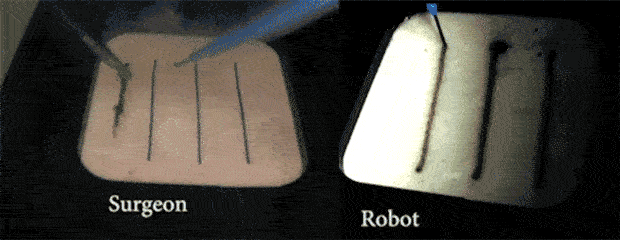Imagine that you’re on the operating table, waiting for surgeons to cut a tumor out of your flesh. You want their cuts to be as precise and accurate as possible, leaving behind no tumor fragments that might cause the cancer to recur, yet also not removing too much healthy tissue.
Rather than an expert human surgeon, you might want the Smart Tissue Autonomous Robot (STAR) hovering over you. In a recent set of experiments, STAR’s inventors showed that it makes more precise cuts than expert surgeons, and damages less of the surrounding flesh. The researchers presented their results at the recent robotics conference IROS 2017.
“I really believe that this is the future of surgery,” says study coauthor Axel Krieger, an assistant professor of mechanical engineering at the University of Maryland.
“I believe this will come about first for small sub-functions of surgery and get more and more complex,” Krieger tells IEEE Spectrum, “similarly to autonomous cars, where small features such as brake-assist slowly morphed into more and more autonomy. I absolutely would trust a robot like that for my surgery, once it is fully developed and validated.”
STAR has previously pulled off some impressive surgical feats. In 2016, the system sewed together two segments of pig intestine with stitches that were more regular and leak-resistant than those of experienced surgeons.
For the current study, the researchers went to a butchershop and purchased three varieties of pig tissue: skin, fat, and muscle. Before they tested the system against human surgeons, STAR first had to prove its ability to make precise cuts in these three types of irregular soft tissue, which can resist a cutting tool and then give way abruptly, causing the tool to make inaccurate cuts.
STAR does its job by visually tracking both its intended cutting path and its cutting tool and constantly adjusting its plan to accommodate movement.
For this visual tracking, the robot relies on tiny marks that the researchers place on the tissue beforehand, which show up on its near-infrared camera. The researchers therefore call STAR a semi-autonomous robot. “After registering the markers, the robot autonomously performs the tumor cutting,” Krieger says.
In the video below, start at 0:35 to see STAR slicing through these three tissue types with a hot electrosurgical tool. The human hand visible in the shots is just holding a vacuum to suck away the vapors produced by the cutting. Krieger explains: “The smell of burning fat and tissue can get pretty bad.”
Having proved that the system can competently cut, Krieger and his colleagues had STAR go head-to-head with expert surgeons on a cutting task in pig skin. (In the video, this part starts around 1:10.)
Both the robot and the surgeons were asked to cut a straight 5-centimeter line. Because surgeons are trained to cut tissue between known landmarks rather than to cut absolute distances, reference lines were drawn on the skin. Some of the surgeons made the cuts in an open surgery setup while others had a laparoscopic setup, the increasingly common surgical practice in which tools are inserted through a tiny hole.
Both the robot and the humans were judged based on how much they deviated from the ideal cut line of the desired length, as well as how much char (damaged flesh) surrounded the incision. The results: STAR’s cuts were closer in length to 5 centimeters, they deviated less from the ideal cut line, and they resulted in less char.
In the final stage of the experiment, the researchers had STAR cut a fake tumor (made of clay) out of a piece of pig fat; a thin piece of tissue was placed above the fake tumor to make it harder for the robot to see its target. The researchers placed markers around the fake tumor’s edges and instructed STAR to cut out the tumor with a 4-millimeter margin on all sides. Again, the robot performed its cuts with great accuracy that would bode well for a cancer patient under its care.
Krieger says the next step is to train STAR to deal with tumors that have complex 3D shapes, which will require new cameras for visual tracking and more sophisticated surgical planning software.
In the paper, the researchers say the robot has real clinical potential. Today, surgeons often mark a tumor’s edges with ink, but they could easily switch to the infrared markers that would allow the robot to go to work. If physicians want to make STAR fully autonomous, the robot could draw information about the tumor’s location from a CT or MRI scan. Then the robot would be fully equipped to be the star of the OR.
Eliza Strickland is a senior editor at IEEE Spectrum, where she covers AI, biomedical engineering, and other topics. She holds a master’s degree in journalism from Columbia University.





